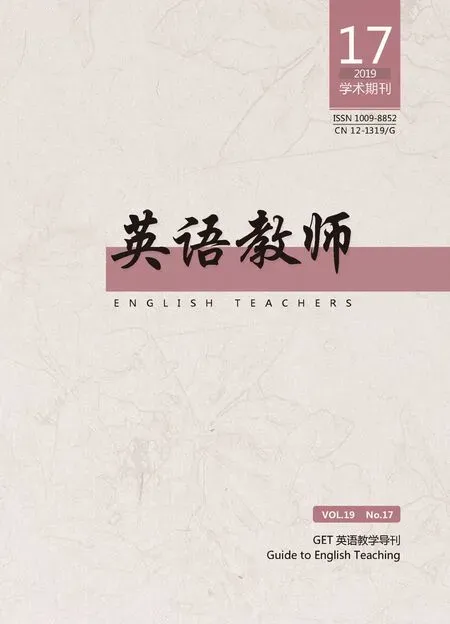在英语诗歌教学中培养学生文化意识的实践
——以Unit 7 Seasons Reading A poem about the seasons 为例
2019-09-09谢建民
谢建民
引言
英语教学应“注重在发展学生英语语言运用能力的过程中,帮助他们学习、理解和鉴赏中外优秀文化,培育家国情怀,坚定文化自信,拓展国际视野,增进国际理解,逐步提升跨文化沟通能力、思辨能力、学习能力和创新能力,形成正确的世界观、人生观和价值观”(教育部2018)。诗歌是文化艺术的精华,蕴含着丰富的文化知识和人文情感。英语诗歌阅读教学在培养学生文化意识方面起着举足轻重的作用。本文以江苏牛津译林版《英语》八年级(上)Unit 7 Seasons Reading A poem about the seasons 教学为例,探讨如何在诗歌教学中培养学生的文化意识。
一、教学内容和学情分析
教学内容为江苏牛津译林版《英语》八年级(上)Unit 7 Seasons Reading A poem about the seasons,是单元的第二课时。学生在第一课时Welcome to the unit 中已经学习了有关天气和季节的知识,基本掌握了有关四季天气的词汇、短语和句型,为在本课综合运用打下了良好的语言能力基础。并且,学生在七年级时就已接触过描述宠物的英语诗歌,为本课诗歌学习打下了文化基础。
二、教学过程
Step 1:播放有关四季的视频,使学生感受天气特点
本环节为热身导入环节,借助有关四季的视频让学生感受四季天气的特点,引导学生复习有关四季天气的单词、短语和句型。
播放关于四季的短片导入新课,询问学生:“What’s your favourite season?What do you do to press your feelings about your favorite season?”学生回答之后,教师总结:“Different people have different feelings about different seasons. And different people have different actions for their favorite season.Some people may sing,some people may dance,some people may write articles. And some people even write poems to press their strong feelings.”
【设计说明】本课时的诗歌主题是四季,在导入新课时,播放有关四季的视频,贴近本单元主题,让学生感受四季的特点,为学生的语言输出提供支架,拉近教师和学生之间的情感距离,为本课教学的顺利实施奠定良好的基础。
Step 2:呈现诗歌,了解文化特征
本环节为读前环节,教师呈现英国著名作家托马斯·纳什(Thomas Nash)所写的英语诗歌Spring,让学生自主阅读,并归纳诗歌的基本特征(见图1)。教学过程如下:
T:An English poem is quite different from other literature forms.What are the characteristics of an English poem?
S1:This poem expresses the poet’s strong feelings.He loves spring very much.
S2:The last word of each line often rhymes with each other.
S3:The line is very short.
S4:We often repeat some words or lines to express our feelings.
S5:We use the capital letter at the beginning of each line.
S6:The poet compares spring to a king.
S7:A poem usually has 4 lines.
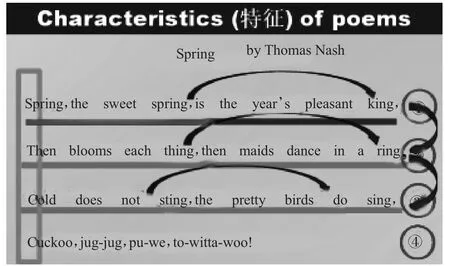
图1
【分析】本环节通过Spring 让学生归纳英语诗歌的特征,主要目的是激发学生已有的文化图式,训练学生的观察能力,为后续英语诗歌中文化知识的学习搭建支架,扫除障碍,培养学生的阅读信心。
Step 3:浏览诗歌,体会文化差异
在学生总结出诗歌的特征之后,进入本堂课的诗歌教学。要求学生阅读英语诗歌Seasons of the year,归纳该诗歌的不同之处,见图2。
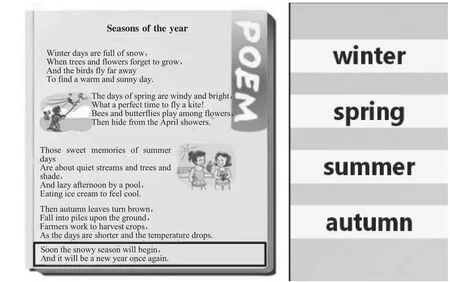
图2
教学过程如下:
T:When you are reading the poem,have you got anything different from the poem?
S1:This poem is written in a different order.It begins with winter.
T:Yes.When we talk about seasons,we usually begins with spring,because spring is the king of the 4 seasons.Why does the poet begin the poem with winter?
S2:Maybe the writer loves winter most.
S3:Maybe because winter is very cold.
S4:Because a new year begins with winter.
T:Yeah!A new year begins on January 1st.Maybe because of a poem by Shelley—If winter comes,can spring be far behind?
T:Anything else different?
S1:The last verse has 6 lines,but the other three verses have 4 lines.
T:Yes.When we create a poem,we usually use the lines of times of 4.However,this poem has 18 lines.Why does the last verse has 6 lines?
S2:I think winter comes after autumn,so the writer uses 6 lines.The last 2 lines here are the connecting links between autumn and winter.
S3:I think a year ends with winter and begins with winter.
...
在师生讨论完后,总结出以下差异:
第一,全诗分为4 个诗节,通常认为春天是一年的开始,而本首诗却是以冬天为开端,在文学作品中比较少见。
第二,诗歌通常为4 句或是4 的倍数句,而本首诗歌有18 句。
要求学生回答作者这样处理诗歌的原因。学生认真思考原因,各抒己见,陈述理由,锻炼思维能力和语言能力。
【设计说明】本环节引导学生运用所学的诗歌文化特征发现这首诗歌的不同之处,训练学生的观察能力,使其体味不同诗歌的文化差异,同时引发思考,培养其思维能力和文化意识。
Step 4:听读诗歌,欣赏节奏韵律
在学生探讨本首诗歌的独特之处后,播放英语诗歌Seasons of the year 的音频。让学生听音频,想象大自然四季的美景,感受诗歌的韵律,找到诗歌的韵脚。然后让学生小声跟读音频,注意诗歌韵律,并大声朗读,感受英语诗歌的韵律美。
教学过程如下:
T:Please listen to the audio of the poem and feel the rhymes.Have you got the rhymes?
Ss:Snow rhymes with grow,away rhymes with day,bright rhymes with kite...
T:OK!Would you please read the poem with the audio and pay attention to the beautiful rhymes?Rhymes make a poem sound more beautiful,right?
Ss:Yes.
T:Great!Please read the poem by yourselves and enjoy the rhymes.
【设计说明】韵律是诗歌的重要特色之一。我国古代文人把诗歌学习归纳为“目视其文,口发其声,心同其情,耳醉其音”。因此,在教学英语诗歌时,要让学生多进行听读、朗读训练,这样能传达出诗歌的思想感情,体现出诗歌内在的音乐美,从而使学生受到强烈的艺术感染,领会和感受诗的意境(李雨晨2007)。
Step 5:品读诗歌,发掘文化意识
在本环节中,通过设计问题引导学生品读诗歌文本,问题如下:“What’s the weather like in...?What does the writer see,hear and do in this season?How does he feel?From what kind of view is the poem written?Which word,phrase or sentence of the poem interest you most?Which season may stand for your age?”学生在回答问题的同时,不仅要认真品读诗歌文本,欣赏优美的语句和精彩的意境,了解诗歌的写作手法,还要识别语篇的类型和结构,辨识和分析语篇的文体特征及衔接手段,分析语篇为传递意义而选用的主要词汇和语法结构,并从诗歌的字里行间推测诗人对季节的情感态度,同时挖掘文本背后蕴藏的文化内涵和价值取向。
以诗歌的第一节——冬季为例展开教学,教学过程如下:
T:What does the writer see in winter?
S1:Snow. Everything is white. Trees and flowers are dead.
T:Are trees and flowers really dead?
S2:No.They just forget to grow.
S3:No,they are saving energy for the spring.They will come out again in spring.
T:Why does the writer say“Trees and flowers forget to grow”instead of“Trees and flowers don’t grow”?
S4:The writer uses humans’behaviour to describe trees and flowers.
T:Right! Here,the writer uses the way of personification to describe plants to make his poem more vivid.And how does the writer feel?
S5:He feels cold and lonely because winter days are full of snow.
S6:He feels lonely because his friends—birds leave him,the birds fly far away to find a warm and sunny day.
T:Yes.Do all the birds fly south to spend the cold winter?
S7:No.Some birds live in one place all year round,while some stay in one place for just a short time.
T:Yes,you are right.For example,sparrows,eagles,crows live in one place all year round,while swans,swallows,cranes stay in one place for just a period of time.OK!Let’s enjoy some beautiful view of winter.
T:Winter is very beautiful.What do you usually do in the beautiful winter?
S8:I usually make snowmen and throw snow balls with my friends.
S9:I usually go skating or go skiing with my parents.
S10:I usually stay at home to accompany with our parents and grandparents.
...
将季节与人生进行对比教学,过程如下:
T:As we know,the four seasons are a circle:winter-spring-summer-autumn. Just like our lives.The seasons repeat and repeat.By the way,which season may stand for your age?
Ss:Spring.
T:Why?
S1:Because we are teenagers.We are young.
S2:Because we active.
S3:Because spring stands for youth and energy.
S4:Because spring is the beginning of seasons.
T:I agree.Since you are“spring”now,what should you do?
S5:We should study hard.
T:Right!What a perfect time to study hard in spring!
S6:We shouldn’t play among flowers and then hide from the April showers.
T:Yes! We should face problems bravely!Although sometimes have snow,wind and showers,sometimes we forget to grow,play and hide,sometimes it is too hot,sometimes we are a little lazy.If we keep trying,never give up,we are sure to have a harvest time.We are sure to have a perfect time and sweet memories during our lives.
【设计说明】解读诗歌文本不能仅仅停留在文本本身的含义、欣赏优美的语句和精彩的意境上,还要引导学生深度挖掘诗歌文本蕴藏的真正文化内涵。因为“诗歌赏读最终都应落实在学生的理解和感悟上,用各种方式带领学生走进文本,就是为了让学生走出文本时能带上新获取的审美能力、新提升的人文素养和新拓展的审美视界”(曹澎2017)。将诗歌描述的每一个季节比作人生的一个阶段(春季—少年;夏季—青年;秋季—壮年;冬季—老年),使学生意识到自己正处于春天的美好年华,不能辜负大好时光。在人生征途中虽然有重重阻碍,但是只要努力学习,奋力拼搏,就能克服困难。
Step 6:翻译诗歌,感知中外文化
在学生充分理解、感悟诗歌文本的基础上,让他们选择这首英语诗歌中的一个季节进行翻译。在翻译之前,教师选择几首与四季有关的中国古诗——《春晓》《小池》《江雪》等作为中国诗歌赏析材料,并以郭沫若和缪斯(Muse)翻译的《春》为例(见图3—图4),引导学生大胆尝试诗歌翻译。
教学过程如下:
T:This English poem is very beautiful,isn’t it?
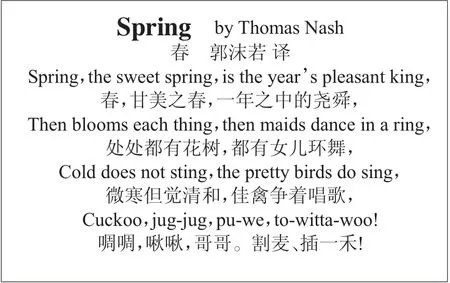
图3
【设计说明】诗歌翻译能够让学生更好地理解中西文化内涵、比较中西文化差异、汲取中西文化精华。“英语学科中的核心素养不仅指向理解外国文化,还包括培养学生的家国情怀”(王滢、吴丽华2018),有利于帮助学生继承和弘扬中华优秀传统文化,熟悉英美等国家的文化特征和思维方式,有效运用英语文化知识提升跨文化交际能力。
Step 7:创作诗歌,升华文化体验
本环节是重要产出环节。学生经过本课时的学习,对英语诗歌有了进一步的了解。让学生四人一组选择季节进行英语诗歌创作,亲身体验英语诗歌文化。
【设计说明】“如果不直接接触相应的语言,就不可能理解文化。”(张红玲2005)不同的人对不同的季节有着不一样的情感。学生进行诗歌创作,一定是有感而发,为学习语言文化知识、汲取文化精华、用英语说中国故事、传播中华文化创造良好的条件。
结束语
语言既是交流的工具,又是文化的载体。在英语诗歌教学中,教师要优化教学方式,科学合理地进行教学设计,为学生提供有效的学习活动,把文化知识有机地融入语言学习活动中,充分挖掘文本的文化内涵,引导学生通过探索、体验、比较、对比等方式学习中外文化知识,将文化知识内化为文化
Ss:Yes.
T:Chinese poems are also beautiful. Would please choose your favourite season and translate this poem into Chinese?Pay attention to the rhymes.Maybe it is difficult for you.I’ll give you some examples.品格,培养文化意识,坚定文化自信,发展多元思维,了解生命的意义与价值,养成积极的生活态度,实现学科育人的目标。
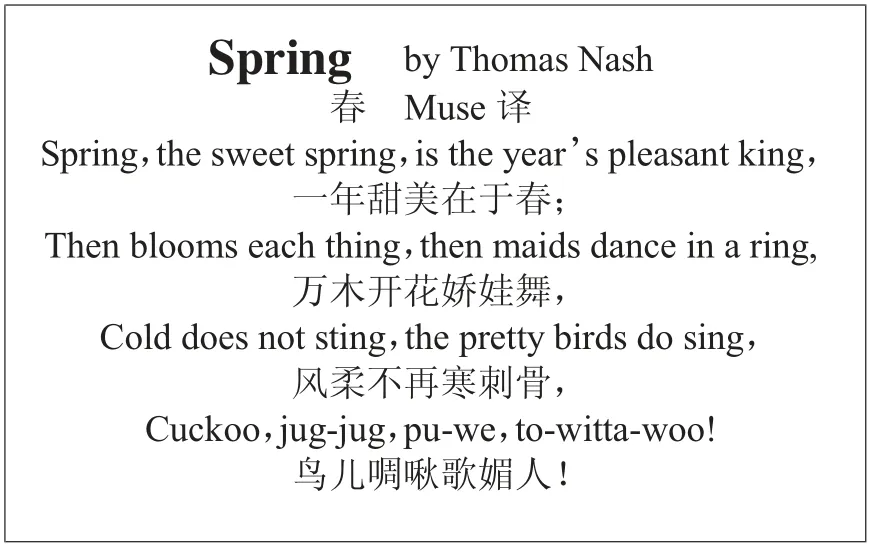
图4
